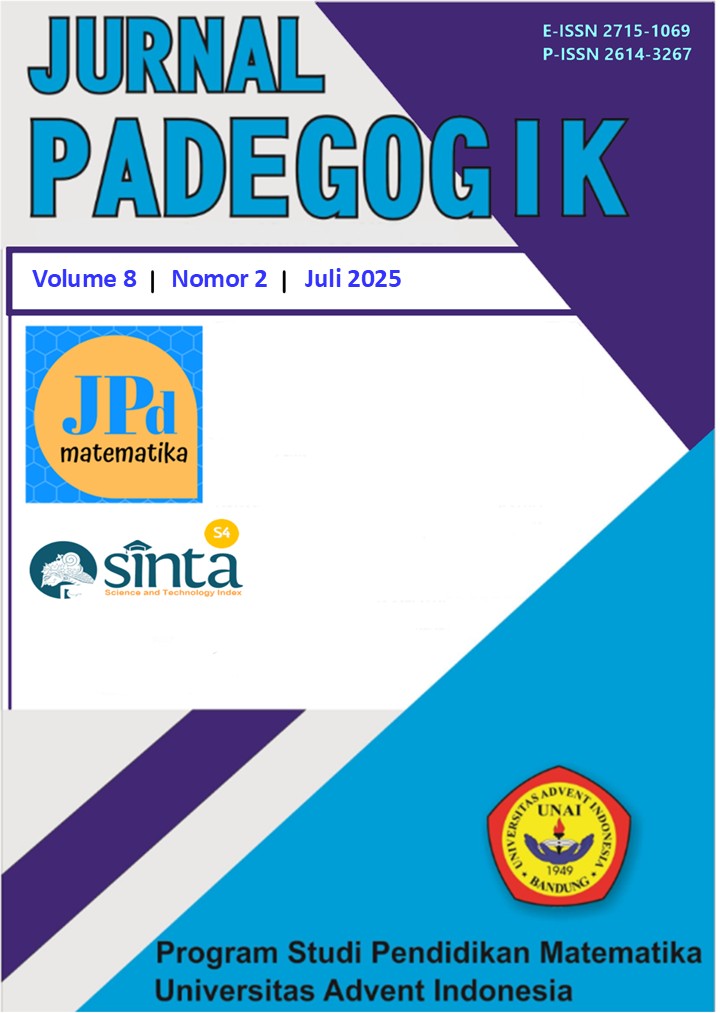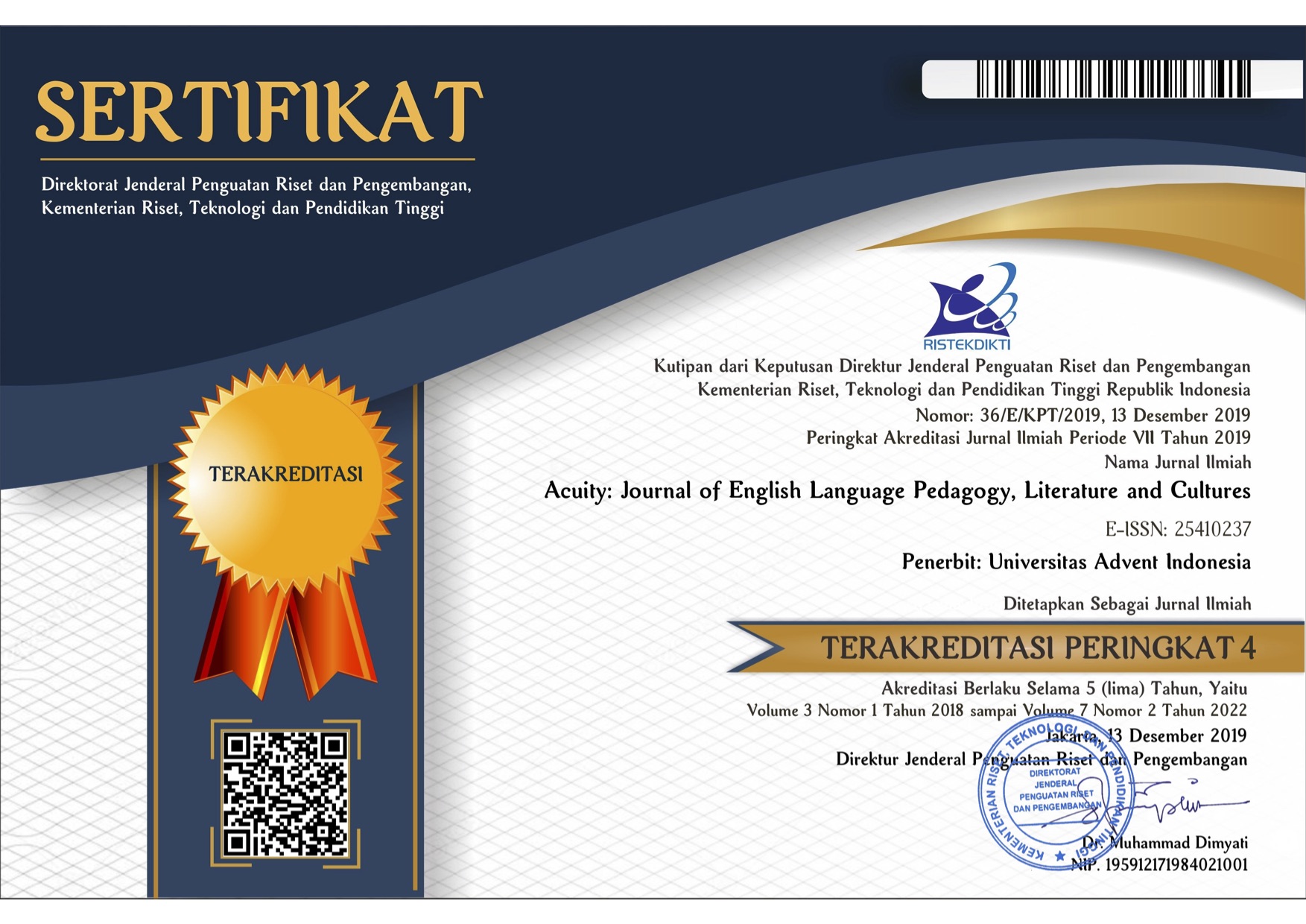Implementation of Problem-Based Learning to Improve Students' Understanding of Basic Probability Concepts
Keywords:
Probability Concept, Problem Based Learning, Classroom Action ResearchAbstract
The purpose of this study was to improve the understanding of class X students towards the concept of probability. The purpose of the study was achieved using a classroom action research method whose action cycle follows the Kemmis & Taggart Model. The classroom action given was the application of a problem-based learning model for 3 cycles. The subjects involved were 12 class X students, the researcher as a teacher, 1 senior teacher as a validator of learning devices and test instruments, and 1 principal as an observer. The research data was taken using a probability concept understanding test instrument in the form of 5 descriptive questions, which were given at the end of each cycle. Learning outcome data were analyzed by calculating the average score and percentage of learning completion. Other data in the form of observer notes were taken using an observation sheet. After the classroom action was carried out, the average score of learning outcomes increased from each cycle, which increased by 33 from cycle I to cycle II, and increased again by 9 from cycle II to cycle III. The application of the problem-based learning model in this study was said to be successful because the achievement of student completion had exceeded 75%, namely in cycles II and III. Thus, the results of this study can be a recommendation for teachers who want to teach the concept of probability.
Downloads
References
Arif, Y. (2024). Pengaruh Pendekatan Pembelajaran TaRL (Teaching at Right Level) dalam Meningkatkan Hasil Belajar Peserta Didik Pada Pelajaran Matematika Di SMKN 8 Surabaya. Perspektif: Jurnal Pendidikan Dan Ilmu Bahasa, 2(2), 159–166. https://doi.org/10.59059/perspektif.v2i2.1292
Astuti, H. W., & Ulia, N. (2025). Pengaruh Pembelajaran Berbasis Masalah berbantuan Kahoot terhadap Kemampuan Pemecahan Masalah Matematika Siswa Sekolah Dasar. JUDIKDAS: Jurnal Ilmu Pendidikan Dasar Indonesia, 4(2), 111–119. https://doi.org/10.51574/judikdas.v4i2.2850
Capaian Pembelajaran Mata Pelajaran Matematika Fase A - Fase F, Kementrian Pendidikan dan Kebudayaan Riset dan Teknologi Republik Indonesia (2022). https://kurikulum.kemdikbud.go.id/file/cp/dasmen/10. CP Matematika.pdf
Daulay, K. A., & Bahri, S. (2022). Analisis Kesalahan Siswa Dalam Mengerjakan Tugas Materi Peluang. Jurnal MathEducation Nusantara, 5(1), 67–73. https://doi.org/10.54314/jmn.v5i1.272
Djadir, Minggi, I., Zaki, A., Ja’faruddin, & Sidara, S. (2017). Sumber Belajar Penunjang PLPG 2017 Mata Pelajaran/Paket Keahlian Matematika: Bab I Peluang. Dirjen Guru dan Tenaga Kepndidikan-Kementerian Pendidikan Dan Kebudayaan. https://www.usd.ac.id/fakultas/pendidikan/f1l3/PLPG2017/Download/materi/matematika/BAB-1-PELUANG.pdf
Fitrah, M. (2017). Pembelajaran Berbasis Masalah Untuk Meningkatkan Pemahaman Konsep Matematika Pada Materi Segiempat. Kalamatika: Jurnal Pendidikan Matematika, 2(1), 51–70. https://doi.org/10.22236/kalamatika.vol2no1.2017pp51-70
Handriastuti, S. W., Nizaruddin, N., Handayani, E. S., & Zuhri, M. S. (2024). Peningkatan Kemampuan Pemahaman Konsep Matematika melalui Pembelajaran Berbasis Masalah Berbantuan Lembar Kerja Siswa. Journal on Education, 7(1), 3703–3712. https://doi.org/10.31004/joe.v7i1.6960
Hasanah, & Bahri, S. (2019). Penerapan Model Pembelajaran Berbasis Masalah Untuk Meningkatkan Pemahaman Konsep Matematika Siswa SD Negeri 101886 Kiri Hilir. Jurnal Pendidikan Dan Pembelajaran Terpadu (JPPT), 01(02), 125–137. https://doi.org/10.32696/pgsd.v1i2.366
Isrok’atun, & Rosmala, A. (2021). Model-Model Pembelajaran Matematika. Bumi Aksara.
Kemmis, S., McTaggart, R., & Nixon, R. (2014). The Action Research Planner: Doing Critical Participatory Action Research. Springer. https://eprints.ukh.ac.id/id/eprint/269/1/2014_Book_TheActionResearchPlanner.pdf
Khasanah, U. (2023). Peningkatan Literasi Sains Peserta Didik Melalui Model Pembelajaran Problem Based Learning (PBL) pada Pembelajaran Biologi Konsep Sistem Imun di Kelas Xi Sma Negeri 5 Kota Serang. Mimbar Kampus: Jurnal Pendidikan Dan Agama Islam, 23(1), 250–256. https://doi.org/10.47467/mk.v23i1.4044
Komarulloh, M. D., Nurimani, & Farisi, S. Al. (2020). Upaya Meningkatkan Hasil Belajar Matematika Siswa melalui Pendekatan Realistic Mathematic Education pada Materi Perbandingan. Prosiding Seminar Nasional Pendidikan STKIP Kusuma Negara II, 369–373. https://jurnal.stkipkusumanegara.ac.id/index.php/semnara2020/article/download/781/430/2864
Kunasaraphan, K. (2018). Classroom action research for teaching mathematics in secondary schools. International Academic Multidisciplinary Research Conference , 433–437. http://www.ijbts-journal.com/images/main_1366796758/65) VI18-1141_Full Paper-Kanokrat Kunasaraphan.pdf
Lara, M., & Syamsurizal, S. (2024). Pengaruh Model PBL (Problem Based Learning) Terhadap Hasil Belajar Siswa Pada Mata Pelajaran Biologi. Jurnal El-Hamra : Kependidikan Dan Kemasyarakatan, 9(2), 27–37. https://doi.org/10.62630/elhamra.v9i2.179
Lumbantoruan, J. H. (2019). Buku Materi Pembelajaran: Teori Peluang Dan Kombinatorika. Program Studi Pendidikan Matematika-FKIP Universitas Kristen Indonesia.
Maghfiroh, A. (2024). Peningkatan Hasil Belajar Siswa Kelas X Pada Materi Peluang Melalui Pendekatan Teaching At the Right Level. SECONDARY: Jurnal Inovasi Pendidikan Menengah, 4(1), 44–54. https://doi.org/10.51878/secondary.v4i1.2798
Mursyidah, D., Lidinillah, D. A. M., & Muharram, M. R. W. (2023). Analisis Kesalahan Siswa SD dalam Menyelesaikan Soal AKM pada Konten Analisis Data dan Peluang Berdasarkan Prosedur Newman. Jurnal Cendekia : Jurnal Pendidikan Matematika, 7(3), 3174–3191. https://doi.org/10.31004/cendekia.v8i1.2773
Natalia, A. E., & Mampauw, H. L. (2024). Analisis Kesalahan Siswa dalam Menyelesaikan Soal AKM Numerasi ditinjau dari Gaya Belajar. Jurnal Cendekia: Jurnal Pendidikan Matematika, 8(3), 1961–1972. https://doi.org/10.31004/cendekia.v8i3.3451
Purnama, A., Wijaya, T. T., Dewi, S. N., & Zulfah, Z. (2020). Analisis Buku Siswa Matematika SMA dari Indonesia dan China Pada Materi Peluang dan Statistik. Jurnal Cendekia : Jurnal Pendidikan Matematika, 4(2), 813–822. https://doi.org/10.31004/cendekia.v4i2.305
Rubianti, T., Priyatni, T., & Supriati, N. (2019). Penerapan Model Problem Based Learning Untuk Meningkatkan Pemahaman Konsep Matematis Siswa Sekolah Dasar di Kelas V. COLLASE:Creative of Learning Students Elementary Education Journal, 02(02), 82–89. https://doi.org/10.22460/collase.v2i2.3143
Saputra, H. (2021). “Pembelajaran Berbasis Masalah (Problem Based Learning).” Jurnal Pendidikan Inovatif, 5(3), 1–9. https://osf.io/mjx82/download
Susanto, R. E. (2024). Efektivitas Pembelajaran Matematika Berbasis Masalah Di Sekolah Menengah Atas. J I I M : Urnal Ilmiah Ipa Dan Matematika, 2(1), 1–5. https://doi.org/10.61116/jiim.v2i1.465
Susilo, H., Chotimah, H., & Sari, Y. D. (2022). Penelitian Tindakan Kelas. Media Nusa Creative.
Usman, A. A., Abbas, N., Oroh, F. A., & Majid. (2023). Penggunaan Model Pembelajaran Index Card Match Dalam Meningkatkan Hasil Belajar Kelas XII Mia 1 SMA Negeri 1 Gorontalo Utara Pada Materi Peluang. Pedagogy: Jurnal …, 8(1), 50–58. https://www.e-journal.my.id/pedagogy/article/view/2330
Zaman, B., Coesamin, M., & Asnawati, R. (2019). Pengaruh Model Pembelajaran Berbasis Masalah Terhadap Pemahaman Konsep Matematis Siswa. Jurnal Pendidikan Matematika Unila, 7(1), 13–24. https://jurnal.fkip.unila.ac.id/index.php/MTK/article/view/17514
Zulfa, A., & Warniasih, K. (2019). Peningkatan Pemahaman Konsep Matematika melalui Model Pembelajaran Problem Based Learning pada Siswa Kelas XI IPS 2 SMA Negeri 1 Gamping. PRISMA, Prosiding Seminar Nasional Matematika, 2(22), 371–375. https://journal.unnes.ac.id/sju/index.php/prisma/article/view/28955
Downloads
Published
How to Cite
Issue
Section
License
Copyright (c) 2025 Jurnal Padegogik

This work is licensed under a Creative Commons Attribution-NonCommercial-ShareAlike 4.0 International License.
The submitting author warrants that
- The submission is original and that she/he is the author of the submission together with the named co-authors; to the extend the submission incorporates text passages, figures, data, or other material from the work of others, the submitting author has obtained any necessary permission.
- Articles in this journal are published under the Creative Commons Share-Alike Attribution Licence (CC-BY-SA What does this mean?). This is to get more legal certainty about what readers can do with published articles, and thus a wider dissemination and archiving, which in turn makes publishing with this journal more valuable for you, the authors.
- By submitting an article the author grants to this journal the non-exclusive right to publish it. The author retains the copyright and the publishing rights for his article without any restrictions.








